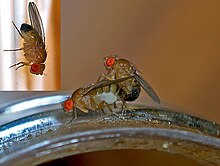
Back Inteling Afrikaans توالد داخلي Arabic Consanguinidá AST İnbridinq Azerbaijani Близкородствено размножаване Bulgarian Parenje u srodstvu BS Inbreeding Czech Indavl Danish Inzucht German Enkruciĝo Esperanto

Inbreeding is the production of offspring from the mating or breeding of individuals or organisms that are closely related genetically.[2] By analogy, the term is used in human reproduction, but more commonly refers to the genetic disorders and other consequences that may arise from expression of deleterious recessive traits resulting from incestuous sexual relationships and consanguinity. Animals avoid incest only rarely.[3]
Inbreeding results in homozygosity, which can increase the chances of offspring being affected by recessive traits.[4] In extreme cases, this usually leads to at least temporarily decreased biological fitness of a population[5][6] (called inbreeding depression), which is its ability to survive and reproduce. An individual who inherits such deleterious traits is colloquially referred to as inbred. The avoidance of expression of such deleterious recessive alleles caused by inbreeding, via inbreeding avoidance mechanisms, is the main selective reason for outcrossing.[7][8] Crossbreeding between populations sometimes has positive effects on fitness-related traits,[9] but also sometimes leads to negative effects known as outbreeding depression. However, increased homozygosity increases the probability of fixing beneficial alleles and also slightly decreases the probability of fixing deleterious alleles in a population.[10] Inbreeding can result in purging of deleterious alleles from a population through purifying selection.[11][12][13]
Inbreeding is a technique used in selective breeding. For example, in livestock breeding, breeders may use inbreeding when trying to establish a new and desirable trait in the stock and for producing distinct families within a breed, but will need to watch for undesirable characteristics in offspring, which can then be eliminated through further selective breeding or culling. Inbreeding also helps to ascertain the type of gene action affecting a trait. Inbreeding is also used to reveal deleterious recessive alleles, which can then be eliminated through assortative breeding or through culling. In plant breeding, inbred lines are used as stocks for the creation of hybrid lines to make use of the effects of heterosis. Inbreeding in plants also occurs naturally in the form of self-pollination.
Inbreeding can significantly influence gene expression which can prevent inbreeding depression.[14]
- ^ Loyau A, Cornuau JH, Clobert J, Danchin E (2012). "Incestuous sisters: mate preference for brothers over unrelated males in Drosophila melanogaster". PLOS ONE. 7 (12): e51293. Bibcode:2012PLoSO...751293L. doi:10.1371/journal.pone.0051293. PMC 3519633. PMID 23251487.
- ^ Inbreeding at the Encyclopædia Britannica
- ^ de Boer RA, Vega-Trejo R, Kotrschal A, Fitzpatrick JL (July 2021). "Meta-analytic evidence that animals rarely avoid inbreeding". Nature Ecology & Evolution. 5 (7): 949–964. Bibcode:2021NatEE...5..949D. doi:10.1038/s41559-021-01453-9. ISSN 2397-334X. PMID 33941905. S2CID 233718913.
- ^ Nabulsi MM, Tamim H, Sabbagh M, Obeid MY, Yunis KA, Bitar FF (February 2003). "Parental consanguinity and congenital heart malformations in a developing country". American Journal of Medical Genetics. Part A. 116A (4): 342–7. doi:10.1002/ajmg.a.10020. PMID 12522788. S2CID 44576506.
- ^ Jiménez JA, Hughes KA, Alaks G, Graham L, Lacy RC (October 1994). "An experimental study of inbreeding depression in a natural habitat". Science. 266 (5183): 271–3. Bibcode:1994Sci...266..271J. doi:10.1126/science.7939661. PMID 7939661.
- ^ Chen X (1993). "Comparison of inbreeding and outbreeding in hermaphroditic Arianta arbustorum (L.) (land snail)". Heredity. 71 (5): 456–461. doi:10.1038/hdy.1993.163.
- ^ Bernstein H, Byerly HC, Hopf FA, Michod RE (September 1985). "Genetic damage, mutation, and the evolution of sex". Science. 229 (4719): 1277–81. Bibcode:1985Sci...229.1277B. doi:10.1126/science.3898363. PMID 3898363.
- ^ Michod RE. Eros and Evolution: A Natural Philosophy of Sex. (1994) Perseus Books, ISBN 0-201-40754-X
- ^ Lynch M (1991). "The Genetic Interpretation of Inbreeding Depression and Outbreeding Depression". Evolution; International Journal of Organic Evolution. 45 (3). Oregon: Society for the Study of Evolution: 622–629. doi:10.1111/j.1558-5646.1991.tb04333.x. PMID 28568822. S2CID 881556.[page needed]
- ^ Whitlock MC (June 2003). "Fixation probability and time in subdivided populations". Genetics. 164 (2): 767–79. doi:10.1093/genetics/164.2.767. PMC 1462574. PMID 12807795.
- ^ Tien NS, Sabelis MW, Egas M (March 2015). "Inbreeding depression and purging in a haplodiploid: gender-related effects". Heredity. 114 (3): 327–32. doi:10.1038/hdy.2014.106. PMC 4815584. PMID 25407077.
- ^ Peer K, Taborsky M (February 2005). "Outbreeding depression, but no inbreeding depression in haplodiploid Ambrosia beetles with regular sibling mating". Evolution; International Journal of Organic Evolution. 59 (2): 317–23. doi:10.1554/04-128. PMID 15807418. S2CID 198156378.
- ^ Gulisija D, Crow JF (May 2007). "Inferring purging from pedigree data". Evolution; International Journal of Organic Evolution. 61 (5): 1043–51. doi:10.1111/j.1558-5646.2007.00088.x. PMID 17492959. S2CID 24302475.
- ^ García C, Avila V, Quesada H, Caballero A (2012). "Gene-Expression Changes Caused by Inbreeding Protect Against Inbreeding Depression in Drosophila". Genetics. 192 (1): 161–72. doi:10.1534/genetics.112.142687. PMC 3430533. PMID 22714404.
© MMXXIII Rich X Search. We shall prevail. All rights reserved. Rich X Search